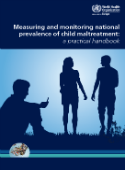Measuring and monitoring national prevalence of child maltreatment: a practical handbook (2016)

Download
By: Franziska Meinck, Janina I. Steinert, Dinesh Sethi, Ruth Gilbert, Mark A. Bellis, Christopher Mikton, Lenneke Alink and Adriana Baban
2016, viii + 39 pages
ISBN 978 92 890 5163 7
The WHO Regional Office for Europe developed this handbook to support the creation of a surveillance system to measure and monitor the prevalence of child maltreatment across European countries. The implementation of a surveillance system is an essential factor in realizing the aims of WHO’s European child maltreatment prevention action plan for 2015–2020.
This handbook describes the processes involved in setting up child-maltreatment surveillance systems and gives recommendations on issues such as selecting a data-collection method, sampling respondents, choosing an instrument to measure abuse and identifying ethical considerations. It suggests community-based surveys on prevalence as the most appropriate method for child-maltreatment surveillance and proposes the use of one of three established questionnaires, based on the results of a rapid systematic review of measures of child abuse. The Short Child Maltreatment Questionnaire is introduced for countries needing a brief measure. Ideally, community-based surveys should be conducted with nationally representative samples of approximately 1500 students in each age group and administered through schools. The use of self-reporting – paper-based or tablet/mobile-telephone self-administered questionnaires – is advised. Questions should capture both the previous-year and lifetime prevalence of child maltreatment. Monitoring prevalence rates over time requires surveys to be conducted repeatedly.
The handbook proposes that surveys be administered every 4–7 years, presents methods of data collection for countries unable to conduct surveys with children and discusses ethical considerations in conducting surveys on child maltreatment.



